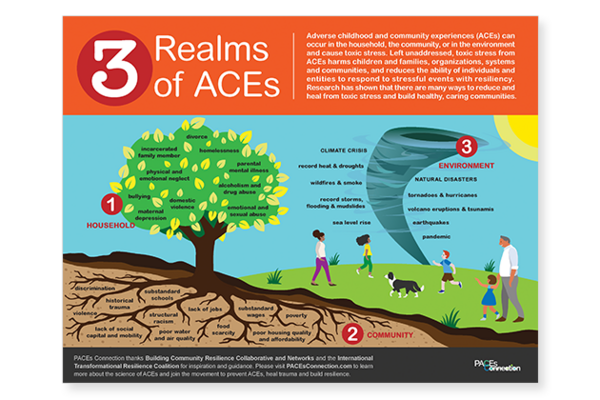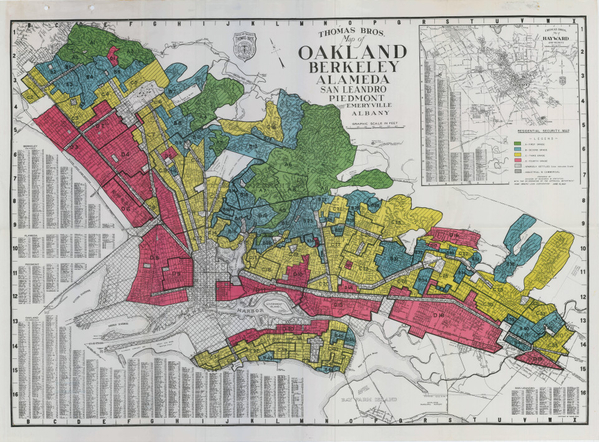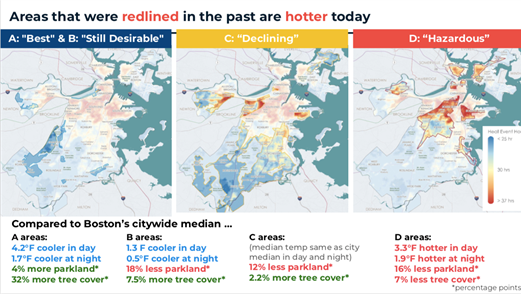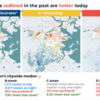This is the first of multiple articles about heat, its impact on us, and what we can do to protect our communities.
It’s hot, and it’s getting hotter. Last month in the United States, over half the population was under heat alerts. In the Southwest, the National Weather Service warned of a “dangerous and deadly heat wave”. No matter where you live in the world, data shows that global surface temperatures have increased year over year. In fact, the three hottest years on record all have happened within the past decade. Rising temperatures will affect us all, but heat is an issue of environmental justice. Populations and communities that have been historically excluded from decision making are going to be the ones most hurt and traumatized by rising temperatures. 
Extreme heat is an adverse childhood experience and an adverse community experience. On the PACEs Connection 3 Realms of ACEs infographic, it’s related to droughts, record heat, wildfires, sea level rise, food scarcity, and poor housing quality. Extreme heat negatively impacts both human mental and physical health, as well as the built infrastructure in which we all live and function.
Heat impacts human health in many ways, from how our bodies can function, to the insects that spread disease. The symptoms of some underlying health conditions, like asthma or heart disease, are worsened by rising temperatures. More acute conditions, like heat stroke and exhaustion, are more likely when it’s hot. Rising temperatures means certain disease-carrying insects can live in more areas of the world, potentially increasing the spread of disease and related deaths. More ticks and mosquitos mean more tick- and mosquito-related illnesses. It’s expected that rising temperatures will cause mental health to worsen. The stress of heat exposure, and an inability to change it, was found to be associated with “increased emergency department visits for mental health conditions like substance misuse, anxiety, schizophrenia, and self-harm”. Those at the most risk of exposure to extreme heat are the elderly, minority groups, women, and children, with compounding effects for vulnerabilities.
Looking beyond the direct impacts of heat on individuals, you can see what heat exposure will do indirectly to our society, too. Heat will have an impact on infrastructure, community relations, and food supply.
On a societal level, heat is expected to cause more conflicts and interpersonal violence worldwide. Temperature affects our ability to grow, produce, and transport food around the world. Temperature increases will lead to greater food scarcity worldwide. Heat causes food spoilage, extreme heat can interrupt food delivery, and less food available means higher prices. Our current aging infrastructure, including our schools, transit systems, and power lines, is also not built to be resilient to rising temperatures. There have already been reports of power lines melting. Even at night, urban areas are difficult to cool down due to residual heat that is held in pavement and buildings. When you are exposed to the heat via work or school, then coming home to an apartment or house that’s still hot, it’s undeniably stressful. There is no break from the oppressive heat we are coming to expect each summer, increasing the risk of heat-related illnesses and stress. We know heat waves are going to last longer if we don’t do anything about climate change, meaning the effects will be magnified.
In some areas, communities have to deal with the increase in heat caused not only by climate change, but also by historical discriminatory practices, such as redlining. The Federal Housing Administration began redlining in the 1930s as a way to compensate for the housing shortage. A combination of federal, state and local policies included things like denying home loans for those in predominantly Black areas and encouraging builders to develop in predominantly white neighborhoods.  The term “redlining” itself came from the actual maps drawn by the Home Owners’ Loan Corporation, where different colors were associated with different levels of riskiness in lending. The areas drawn in red were perceived as the riskiest to buy or insure.
The term “redlining” itself came from the actual maps drawn by the Home Owners’ Loan Corporation, where different colors were associated with different levels of riskiness in lending. The areas drawn in red were perceived as the riskiest to buy or insure.
In cities like Boston and New Orleans, and others with a history of redlining, one of the effects has been increased temperatures in previously redlined neighborhoods. This is due to the unintentional creation of heat islands and a lack of green space from neglectful planning. Heat islands are when there is a distinct temperature difference between a neighborhood and the surrounding city. According to the EPA, “the heat island effect results in daytime temperatures in urban areas about 1–7° F higher than temperatures in outlying areas and nighttime temperatures about 2–5° F higher.” Neighborhoods that were redlined have half as many trees on average today and less green space compared with the then highest-rated predominantly white neighborhoods in those same areas. A study from early 2020 found that formerly redlined neighborhoods of almost every city included in the study were hotter than non-redlined neighborhoods. Historically underserved neighborhoods and communities experience more intense heat island effect, compounding the trauma they are already experiencing from other source.

Source: City of Boston Extreme Heat Open House
Extreme heat is an issue of climate justice and environmental justice. These redlined neighborhoods are hotter, were historically underinvested in, have worse infrastructure, and are more likely to have residents with pre-existing health conditions that will be exacerbated by heat. The burden of heat is felt primarily by communities of color and those who are low-income. The impact of all of these compounding experiences will create even more trauma and psychosocial stress. It’s stressful for the adults who understand it, and it’s stressful for the children in our lives who may or may not understand it, but still feel the temperatures rising.
To create resilient and thriving communities, we must address the threat that climate change and rising temperatures cause.
So what can you do?
Stay tuned for the follow up to this article, “How to protect your children and your communities from summer heat.”
To find out more about the field of environmental justice join the free PACEs Connection Creating Resilient Communities Accelerator Program.





Comments (2)